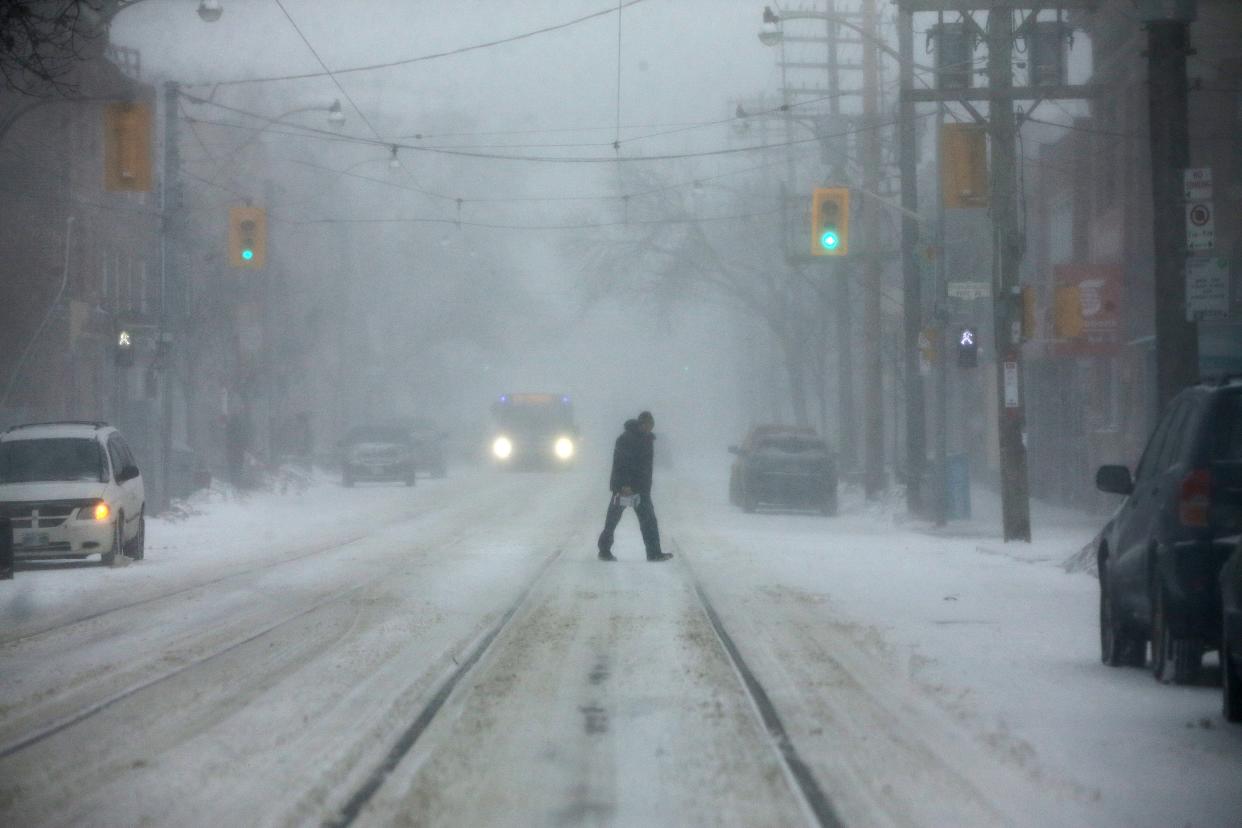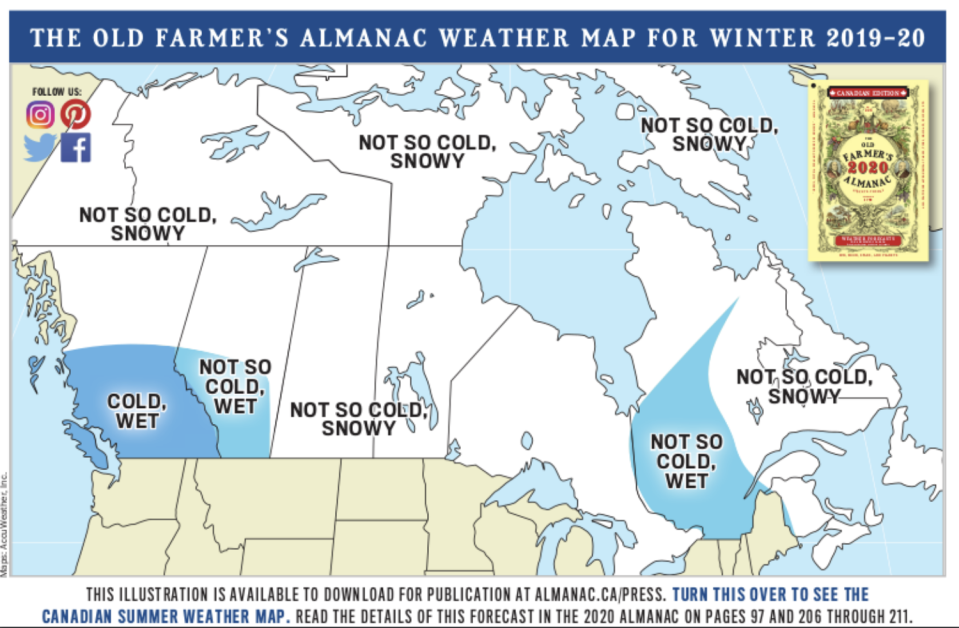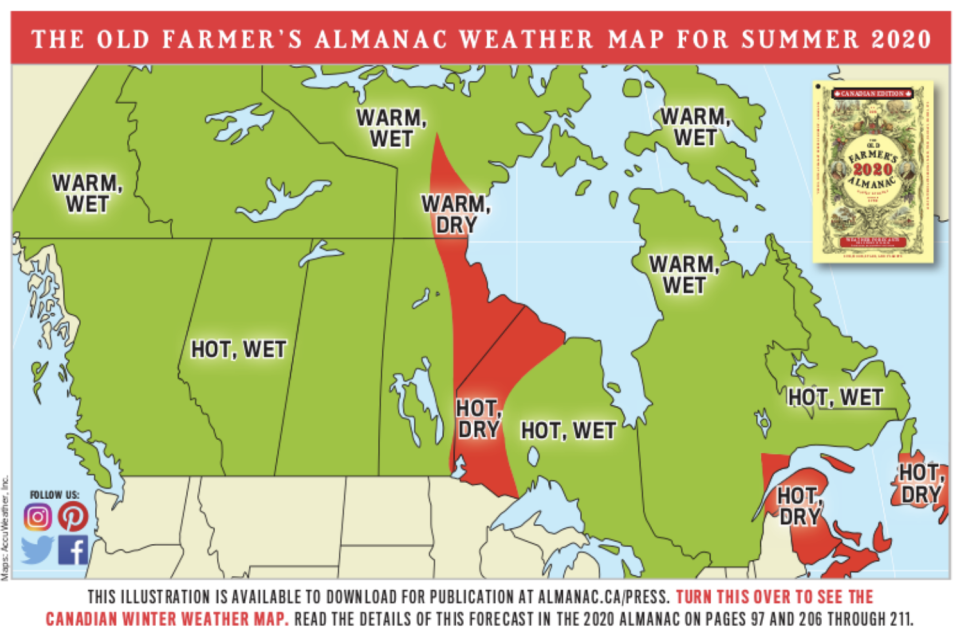'The game of snows': Canada's first winter forecast of the year

As the summer season approaches its end, the Old Farmer’s Almanac has used their legendary forecasting system to predict the weather across the country until fall 2020.
Winter
Overall, the weather in Canada this winter is expected to be warmer-than-normal throughout the season. The exception will be B.C., where residents will see cooler temperatures.
“It’s not really going to be a bone-chilling winter, except in southern B.C.,” Jack Burnett, managing editor at the Old Farmer’s Almanac told Yahoo Canada.
If you’re looking forward to the milder weather, don’t get too excited, because precipitation is predicted to be above normal across much of the country.
“We’re calling it the game of snows,” Burnett said. “We’re looking for it to be snowy across just about the entire country.”

Snowfall is also expected to be below normal in central and southern Quebec, and southern B.C. and southern Alberta.
“So if it’s wetter in southern B.C. and colder, it looks to me like it’s icier,” Burnett said.
Ontario is expected to start seeing some cooler temperatures in mid-to-late November, while B.C., Atlantic Canada and southern Quebec won’t see its colder days until at least mid-December. The Prairies coldest temperatures aren't expected to show up until January 2020.
According to Burnett, Canadians are looking at 8 to 11 major snow storms in the winter in every place but B.C. The dates are as follows:
Maritimes: Dec. 9, Jan. 1 and Jan. 31
Quebec: Dec. 10., Feb. 19, Mar. 28 (western Quebec)
Ontario: Jan. 19, Jan. 23 and Feb. 19
Prairies: Dec. 15 and Mar. 29
Spring
Spring will be a bit more variable throughout Canada, but temperatures will be below normal in the Maritimes, Quebec and the Prairies. While much of the rest of the country is expected to see temperatures tipping above normal for the season.
In terms of precipitation, northern Atlantic Canada, eastern Ontario, the Prairies and central B.C. will see more than usual.

Summer
A milder winter is what many people are looking for but an overly hot summer - not so much. Unfortunately, the Old Farmer’s Almanac thinks that’s going to be the pattern in the 2020 season.
“We’re looking for it to be hot all across the country, from B.C. all the way out to Labrador,” Burnett said.
Additionally, precipitation is expected to be above normal for much of the country, with most of the Maritimes and western Ontario, north to Nunavut, being the exceptions.
The hottest days in the Maritimes, southern Quebec and the Prairies will first hit in mid-June, while Ontario and B.C. will start seeing some of its warmer temperatures later in the month.

Fall
The warmer weather will continue into fall 2020, with above normal temperatures predicted in the Maritimes, southern Quebec and Ontario, the Prairies and B.C.
Precipitation will be below or near normal in Ontario, the Prairies and eastern B.C., while other areas will see more than normal for the season.
How can they predict the weather so far in advance?
For decades, the Old Farmer’s Almanac has been predicting the weather over a year in advance, an odd phenomenon when more traditional forecasters occasionally have trouble developing a forecast only days earlier.
The Almanac uses a “secret formula,” developed by founder Robert B. Thomas in 1792.
The three components that are studied to make up their forecasts are: solar science and the study of solar activity like sunspots, climatology (weather patterns, long-term weather trends) and meteorology.
“We have long since turned...those three things into computer algorithms,” Burnett said.
According to the Old Farmers’ Almanac, weather trends are compared with solar patterns and historical weather conditions.
“We look at the weather patterns in the present, then using computers we go back into the past and try to find the time in the past that most closely resembles the present,” Burnett explained. “Then we’ll go back in the past and says ‘what happened next then.’”
According to the publication’s editor, the Almanac’s weather forecasts have been approximately 80 per cent accurate through the years. Last year they were between around 71 per cent accurate in Canada.
In terms of being compared to other forecasts, like the ones created by Environment Canada, Burnett is not in competition with them.
“I always say it’s like we’re making soup,” Burnett said.
“We take the same ingredients that we get from satellites and sensor and everything else, we put them into our soup pots, we may [use] different proportions and we may use a slightly different recipe...and in the end we have two soups, and most people, when they try them, like them both.”


